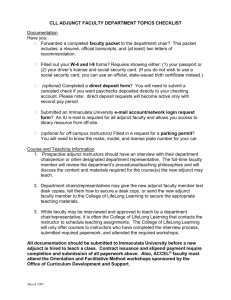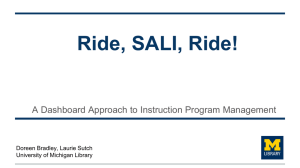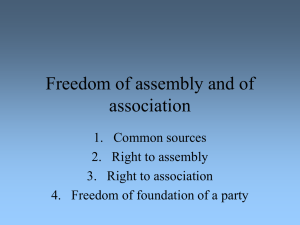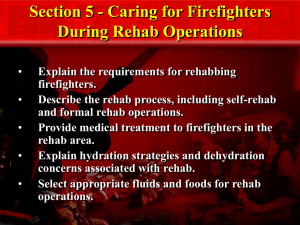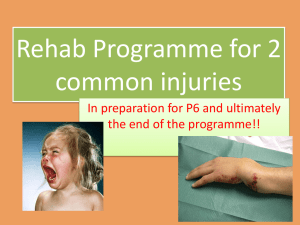Guidelines and Positions PPT
advertisement
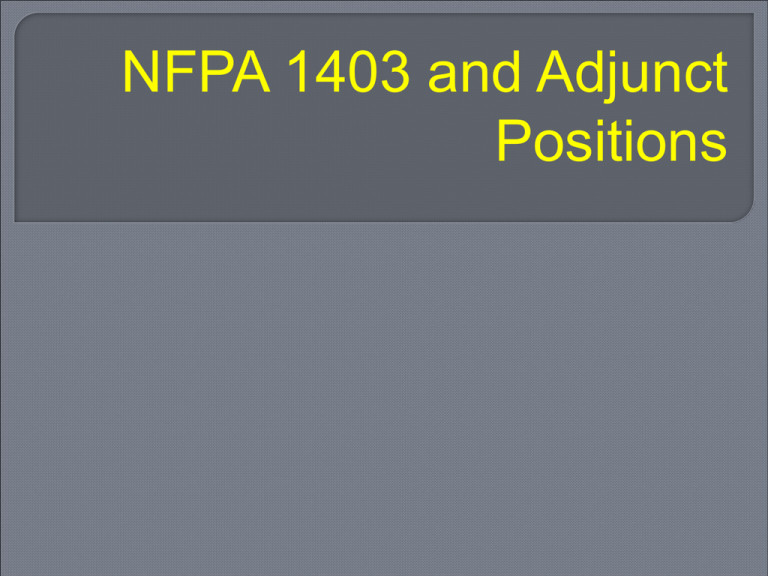
NFPA 1403 and Adjunct Positions At the end of class; the student will be able to match responsibilities with live fire adjunct positions, identify safety concerns, describe rehab requirements, and documentation procedures according to the Gwinnett Live Fire Guidelines and NFPA 1403. 1. After lecture, discussion, demonstration, and practice, the student will describe an assigned adjunct position when given a specific scenario. 2. After lecture, discussion, demonstration, and practice, the student will be able to identify possible consequences associated with unsafe actions in live fire training. 3. After lecture, discussion, demonstration, and practice, the student will be able to determine rehab requirements associated with a given situation. 4. After lecture, discussion, demonstration, and practice, the student will be able to recognize the components of the Gwinnett Fire Heat Stress Prevention System. 5. At the conclusion of class, the student will be able to choose the proper method to document training associated with performing as a Live Fire Adjunct Instructor with Gwinnett County Fire. Standard on Live Fire Training Evolutions Scope • This is the guideline that governs us, and is in place to help keep us as instructors and the students safe. • Contains the minimum requirements for training all fire suppression personnel engaged in firefighting operations under live fire conditions. The purpose of this standard is to provide a process for conducting live fire training evolutions to ensure that they are conducted in safe facilities and that the exposure to health and safety hazards for the fire fighters receiving the training minimized. NFPA 1403 – Firefighter I G.C. Fire Academy – Relief Driver Built in 1998. High Temperature linings. Two story concrete structure, with eight rooms, five of which are constructed for actual fires. An interior stairwell with standpipe system, a roof with ventilation simulator, and an attic simulator are also part of the structure. The interior is equipped with thermal couplers that read temperatures in each room. (May not work) The command room is located upstairs in Butler Building. “Driver Training Office” There is also a quick vent system for smoke evacuation, controls are located in command room. Also, command room has TV with TIC transmitter. Burn building should be inspected once every year for any structure that supports more than 60 days of live fire during a year. Building shall be inspected for damage prior to live fire training and documented. • All doors, window, ventilation systems, standpipes, etc…. All hazardous conditions shall be removed. Debris should be removed. Exits should be identified and evaluated. Should be no fire located in exit paths. Instructor-in-charge shall determine the GPM and that a positive water source is obtained for the entire duration of the operation. • Should have 50% of the fire flow required available for unforeseen situations. • 95 GPM minimum flow rate. Separate sources shall be utilized for the supply of attack lines and backup lines. Areas for staging, operating, and parking of fire apparatus that are used in the live fire training evolution shall be designated. Parking area for an ambulance shall be designated and located where it will facilitate a prompt response in the event of personal injury to participants. Pre-fire briefing session shall be conducted for all participants, in which all facets of each evolution to be conducted are discussed and assignments for all crews participating in the training session are given. The location of simulated victims shall not be required to be disclosed, provided that the possibility of victims is discussed during pre-fire briefing. NO REAL LIFE VICTIMS, NO EXCEPTIONS!!!!!!!! A pre-fire plan shall be prepared and shall be utilized during the pre-fire briefing. (Incident Objectives) • Weather included on report. All participants shall be required to conduct a walk-through of the acquired structure in order to have a knowledge of and familiarity with the layout of the structure and to facilitate any necessary evacuation. Shall have known burning characteristics that are controllable. Pressure treated wood, rubber, plastic, straw or hay treated with pesticides or other harmful chemicals shall not be used. Avoid fuel loads that could cause a backdraft or flashover. Combustible or flammable liquids shall not be used unless designed for. Ordinary combustibles ONLY. All visitors shall be identified and escorted at all times. Safety Officer will identify parameters for the visitors to stay in. All possible sources of ignition shall be removed from the operations area. Shall not exceed a student-to-instructor ratio greater than 5 to 1. Ensure all PPE is in proper working order and is worn to manufactures specifications. Recorder Incident Commander (IC) Team Leader Safety (Interior and Exterior) Rapid Intervention (RIC) Rehab Medical Treatment Apparatus Operator Ignition Located in upstairs of butler building Needs to document everything Will be provided forms to use Has access to video feed from thermal imagers Shall maintain report on all live fire training evolutions, including: • Accounting of activities • Instructors present/assignments • Students present/assignments • Documentation of unusual conditions • Any injuries • Any structural changes Should help with post-training critique Responsible for the overall training scenario just as an IC would be at a actual scene. (Instructor-in-Charge) Needs to be an academy staff member to ensure familiarity with the scenario. Follow incident objectives (Preselected). Briefs all instructors and students Ensures a radio check is completed Monitors the location of all personnel Responsible for the overall safety and smooth operation of the training Determines Rehab times based on conditions. This role is very important Will be leading the students during the scenario Assigned fire attack, ventilation, RIC, search, or a combination Double check student’s protective gear before the scenario begins You must stop any unsafe actions Make a mental note of any student deficiencies to pass along to supervision Shall monitor and supervise all assigned students during live fire training. Perform a head count before and after. Interior and Exterior • Ensures the safety of all personnel including instructors, students, and visitors. • Shall be appointed for all live fire training. • Must wear minimum of helmet and jacket, including a radio. At least one exterior safety At least one interior safety on each fire floor Use thermal imager so it can be viewed in the recording room Interior- Check and clear your area before exiting (“Interior out of structure, all clear”) Exterior- Be alert until everyone has exited the drill area (“Everyone is accounted for, this drill is called”) Get your mind focused on safety Forecast what might happen • Prevention of unsafe acts • Elimination of unsafe conditions Will be positioned to respond quickly Charged Have hoseline all PPE on and “ready to click in” Will have liquids and medical equipment Monitor and record vital signs Use matrix form to ensure everyone reports as scheduled Do not release anyone who doesn’t meet guidelines Report any problems to IC • Includes all instructors and students. For treatment of injuries or emergencies Med unit on scene if available Need ALS capabilities Guidelines require backup line on each fire floor Backup lines shall have an independent water source Two full tanks of water maintained Conserve water Tighten connections Shut down tank fill if it overflows Drafting may be required At conclusion, all lines will be drained to the storage pit Only responsible for ignition Can not enter the building until all safety and RIC personnel are in place with charged hoseline. Command will give you permission to enter Shall not be assigned any students. Communicate when you enter and exit the building. • Ignition must leave the building once incipient fire is established. (Starts to rollover, get our) Our guideline is a maximum of 6 pallets, one bail of hay, and may use some smaller particle board if needed. If an evacuation is deemed necessary, the Fire Academy Guidelines shall be followed. Participants shall hear over the radio “Emergency Traffic- All personnel evacuate.” 3 blast on air horn, each 3 seconds long. If team leader advise students to drop lines, account for all personnel and get out. Once your outside account for all personnel again. A PAR shall follow. The proper response is E1 acknowledge PAR: “E1 OK”. All personnel assigned a position shall be issued a radio. Use Talk-Around, “all the way to the right.” • Unless advised otherwise be IC. Injuries Low air alarms Recruits/lack of experience Exposure to fire/high heat Physical/Medical conditions Proper rehab Weather concerns Mounted Work on academy wall on B/C corner levels (easy, moderate, strenuous) Work/Rest Bunker ratios gear effects the index What would the work/rest ratio be for a person training in the burn building in full PPE and breathing air if the WBGT was reading 82? What would the work/rest ratio be for a person training in the burn building in full PPE and breathing air if the WBGT was reading 82? Strenuous work 82 plus 5 for the gear= 87 Answer is 30/30 Live Fire Adjunct Positions Evacuations Communications Safety Concerns Rehab Documentation Procedures
